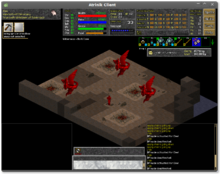Isometric engine

An isometric engine is a specific form of graphics engine . It supports the display in computer games. It tries to simulate three-dimensionality through isometry without resorting to a computationally intensive real 3D engine .
description
In order to create the impression of three-dimensionality, the square (sometimes also hexagonal) fields of a map are shown in a distorted perspective, but without spatial shortening, so that all fields have the same shape regardless of the distance to the player's point of view. (See also: parallel projection ) This means that they can be represented simply using two-dimensional ( raster ) graphics.
An isometric engine usually consists of four components:
- Tile plotter
- Translation of the coordinates of the isometric map into the coordinates of the screen
- Mouse mapper
- Translation of the coordinates of the screen (screen space) into the coordinates of the isometric map (game space)
- Tile Walker
- Allows movement on the isometric map
- Tiles
- Textures drawn on the map
Isometry card
There are different types of isometric maps:
- Staggered map
- Diamond Map
They differ in their shape, i. H. the arrangement and numbering of the tiles on the screen.
A basic distinction is also made between 45 ° isometric engines and 30 ° isometric engines. However, this has no effect on the different types of maps, only on the display.
Scrolling
This refers to the ability to move the virtual camera over the map, i. H. Areas that cannot be shown on the screen because the map is larger than the screen can be shown by moving the map section.
Pathfinding
In order for a pawn to move on this map, it must have a certain amount of artificial intelligence. She must be able to avoid objects and find the optimal route from a starting point to a destination. There are special path finding algorithms such as the A * algorithm .
applicability
Most games of the newer generation are equipped with a 3D engine, as this opens up new and improved graphical and playful possibilities. The use of isometric and tile engines in general is increasingly unusual in the professional sector. Nevertheless, there is the advantage that the required computing power is less with isometric engines than with 3D engines.
Web links
- Vogler, Benedikt: Creation of a game engine based on blocks in Java (PDF; 8.8 MB) , 2013, Written report on an isometric game engine